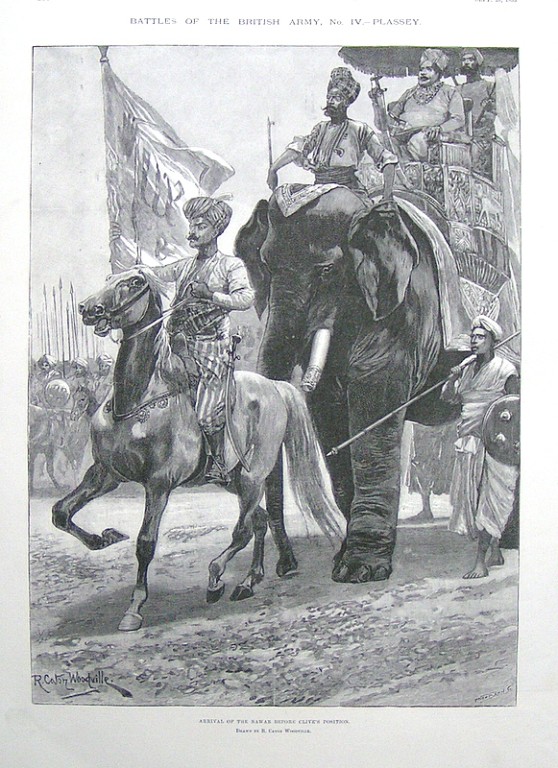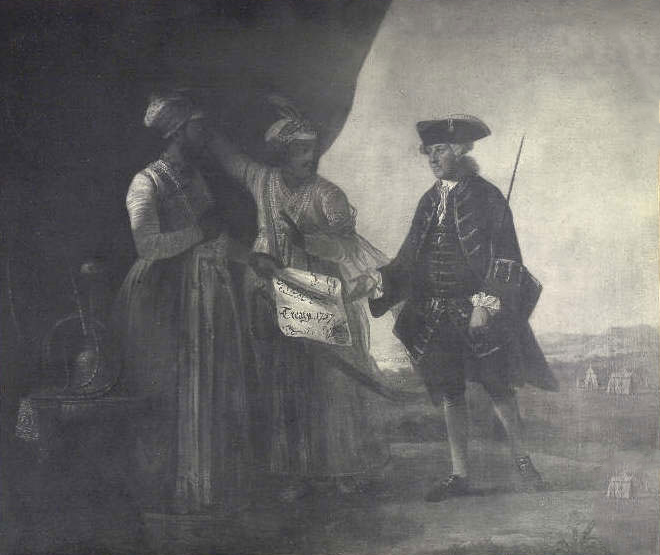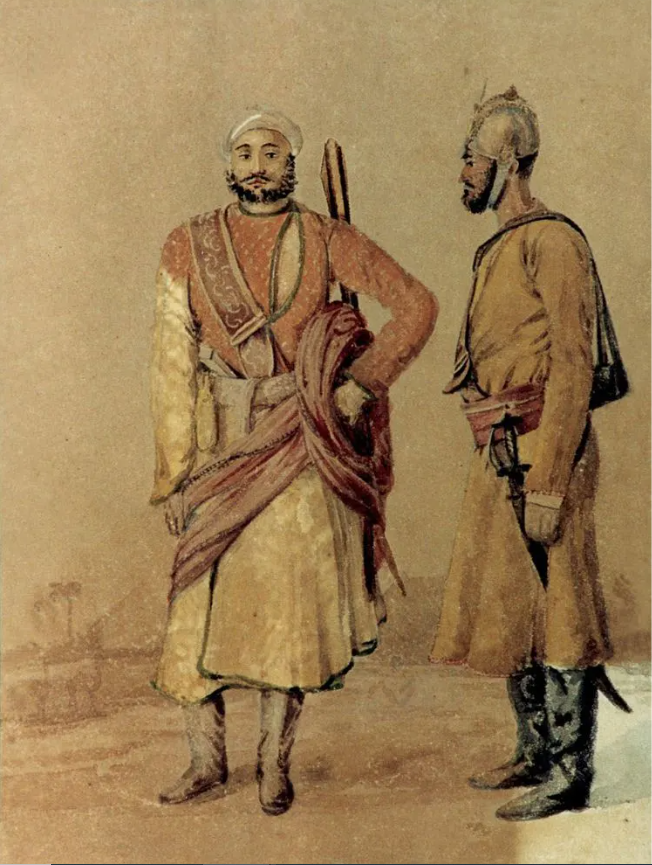|
Dastak (trade Permit)
Dastak was a trade permit mostly issued to European traders by officials of the East India Company. The trade permit waived customs or transicharges for personal goods. The power to issue trade permits was conferred upon Company officials by the Mughal Emperor Farrukhsiyar after William Hamilton (surgeon), William Hamilton, a surgeon associated with the Company cured him of a disease. Definition The practice of using dastaks for almost any goods was consolidated by Robert Clive when he overthrew the then Nawabs of Bengal and Murshidabad, Nawab of Bengal, Mir Qasim, Mir Quasim after he opposed the British East India Company's position that their dastaks meant that they could trade without paying taxes (other local merchants with dastaks were required to pay up to 40% of their revenue as tax). The British then seized control of the province of Bengal by reinstating puppet ruler Mir Jafar. Advantages The dastak was a important reason for the impoverishment of Bengal. Company offic ... [...More Info...] [...Related Items...] OR: [Wikipedia] [Google] [Baidu] |
Farrukhsiyar
Farrukhsiyar or Farrukh Siyar () (20 August 16839 April 1719) was the tenth emperor of the Mughal Empire from 1713 to 1719. He rose to the throne after assassinating his uncle, Emperor Jahandar Shah. Reportedly a handsome man who was easily swayed by his advisers, he lacked the ability, knowledge and character to rule independently. He was an emperor only in name, with all effective power in the hands of the Sayyids of Barah. Farrukhsiyar was the son of Azim-ush-Shan (the second son of emperor Bahadur Shah I) and Sahiba Niswan. Early life Muhammad Farrukhsiyar was born on 20 August 1683 (9th Ramzan 1094 AH) in the city of Aurangabad on the Deccan plateau. He was the second son of Azim-ush-Shan, who was a grandson of the Mughal emperor Aurangzeb and son of the later emperor Bahadur Shah I. In 1696, Farrukhsiyar accompanied his father on his campaign to Bengal. Aurangzeb recalled Azim-ush-Shan from Bengal in 1707 and instructed Farrukhsiyar to take charge of the province. F ... [...More Info...] [...Related Items...] OR: [Wikipedia] [Google] [Baidu] |
William Hamilton (surgeon)
William Hamilton (died 4 December 1717) was a Scottish surgeon, associated with British East India Company (EIC), who travelled to India in the first half of the eighteenth century. He was a part of the delegation that went from Calcutta, the base of the company, to meet Mughal emperor Farrukhsiyar in his court in Delhi in 1715. Early life William Hamilton was born in Lanarkshire in the latter part of the seventeenth century, and possibly studied at Glasgow University. He travelled with the East India Company on the ''Sherborne'' in 1709, but deserted it at Cuddalore. After finding his way to Madras, he was summoned back to the ship before again absconding to Calcutta. Treatment of Farrukhsiyar In Delhi, Hamilton first had to treat Taqarab Khan (the ''khansama'', or lord steward). In August 1715, the surgeon was called to treat a swelling in the groin of the Emperor Farrukhsiyar, which he treated successfully. In October of the same year, the emperor again suffered from violent ... [...More Info...] [...Related Items...] OR: [Wikipedia] [Google] [Baidu] |
Robert Clive
Robert Clive, 1st Baron Clive, (29 September 1725 – 22 November 1774), also known as Clive of India, was the first British Governor of the Bengal Presidency. Clive has been widely credited for laying the foundation of the British East India Company rule in Bengal. He began as a writer (the term used then in India for an office clerk) for the East India Company (EIC) in 1744 and established Company rule in Bengal by winning the Battle of Plassey in 1757. In return for supporting the Nawab Mir Jafar as ruler of Bengal, Clive was granted a jagir of £30,000 () per year which was the rent the EIC would otherwise pay to the Nawab for their tax-farming concession. When Clive left India he had a fortune of £180,000 () which he remitted through the Dutch East India Company. Blocking impending French mastery of India, Clive improvised a 1751 military expedition that ultimately enabled the EIC to adopt the French strategy of indirect rule via puppet government. Hired ... [...More Info...] [...Related Items...] OR: [Wikipedia] [Google] [Baidu] |
Nawabs Of Bengal And Murshidabad
The Nawab of Bengal ( bn, বাংলার নবাব) was the hereditary ruler of Bengal Subah in Mughal India. In the early 18th-century, the Nawab of Bengal was the ''de facto'' independent ruler of the three regions of Bengal, Bihar, and Orissa which constitute the modern-day sovereign country of Bangladesh and the Indian states of West Bengal, Bihar and Orissa. They are often referred to as the Nawab of Bengal, Bihar and Orissa ( bn, বাংলা, বিহার ও উড়িষ্যার নবাব). The Nawabs were based in Murshidabad which was centrally located within Bengal, Bihar, and Odisha. Their chief, a former prime minister, became the first Nawab. The Nawabs continued to issue coins in the name of the Mughal Emperor, but for all practical purposes, the Nawabs governed as independent monarchs. Bengal continued to contribute the largest share of funds to the imperial treasury in Delhi. The Nawabs, backed by bankers such as the Jagat Seth, became th ... [...More Info...] [...Related Items...] OR: [Wikipedia] [Google] [Baidu] |
Mir Qasim
Mir Qasim ( bn, মীর কাশিম; died 8 May 1777) was the Nawab of Bengal from 1760 to 1763. He was installed as Nawab with the support of the British East India Company, replacing Mir Jafar, his father-in-law, who had himself been supported earlier by the East India Company after his role in winning the Battle of Plassey for the British. However, Mir Jafar eventually ran into disputes with the East India Company and attempted to form an alliance with the Dutch East India Company instead. The British eventually defeated the Dutch at Chinsura and overthrew Mir Jafar, replacing him with Mir Qasim. Qasim later fell out with the British and fought against them at Buxar. His defeat has been suggested as a key reason in the British becoming the dominant power in large parts of North and East India. Early life and family Sayyid Mir Qasim was the son of Mir Muhammad Razi Khan, and claimed descent from Ali al-Ridha. His paternal grandfather, Sayyid Husayn Ridhwi, entered the M ... [...More Info...] [...Related Items...] OR: [Wikipedia] [Google] [Baidu] |
Mir Jafar
Sayyid Mīr Jaʿfar ʿAlī Khān Bahādur ( – 5 February 1765) was a military general who became the first dependent Nawab of Bengal of the British East India Company. His reign has been considered by many historians as the start of the expansion of British control of the Indian subcontinent in Indian history and a key step in the eventual British domination of vast areas of pre-partition India. Mir Jafar served as the commander of the Bengali army under Siraj ud-Daulah, the Nawab of Bengal, but betrayed him during the Battle of Plassey and succeeded Daulah after the British victory in 1757. Mir Jafar received military support from the East India Company until 1760, when he failed to satisfy various British demands. In 1758, Robert Clive discovered that Jafar had made a treaty with the Dutch East India Company at Chinsurah through his agent Khoja Wajid. Dutch ships of the line were also seen in the River Hooghly. Jafar's dispute with the British eventually led to the Battle o ... [...More Info...] [...Related Items...] OR: [Wikipedia] [Google] [Baidu] |
Warren Hastings
Warren Hastings (6 December 1732 – 22 August 1818) was a British colonial administrator, who served as the first Governor of the Presidency of Fort William (Bengal), the head of the Supreme Council of Bengal, and so the first Governor-General of Bengal in 1772–1785. He and Robert Clive are credited with laying the foundation of the British Empire in India. He was an energetic organizer and reformer. In 1779–1784 he led forces of the East India Company against a coalition of native states and the French. Finally, the well-organized British side held its own, while France lost influence in India. In 1787, he was accused of corruption and impeached, but after a long trial acquitted in 1795. He was made a Privy Councillor in 1814. Early life Hastings was born in Churchill, Oxfordshire, in 1732 to a poor gentleman father, Penystoe Hastings, and a mother, Hester Hastings, who died soon after he was born. Despite Penystone Hastings's lack of wealth, the family had been lord ... [...More Info...] [...Related Items...] OR: [Wikipedia] [Google] [Baidu] |
Government Of The Mughal Empire
The government of the Mughal Empire was a highly centralised bureaucracy, most of which was instituted during the rule of the third Mughal emperor, Akbar. The central government was headed by the Mughal emperor; immediately beneath him were four ministries. The finance/revenue ministry was responsible for controlling revenues from the empire's territories, calculating tax revenues, and using this information to distribute assignments. The ministry of the military (army/intelligence) was headed by an official titled ''mir bakhshi'', who was in charge of military organisation, messenger service, and the '' mansabdari'' system. The ministry in charge of law/religious patronage was the responsibility of the ''sadr as-sudr,'' who appointed judges and managed charities and stipends. Another ministry was dedicated to the imperial household and public works. Provinces The empire was divided into a number of '' subahs'' (provinces), each of which was headed by a provincial governor c ... [...More Info...] [...Related Items...] OR: [Wikipedia] [Google] [Baidu] |
Bengal Presidency
The Bengal Presidency, officially the Presidency of Fort William and later Bengal Province, was a subdivision of the British Empire in India. At the height of its territorial jurisdiction, it covered large parts of what is now South Asia and Southeast Asia. Bengal proper covered the ethno-linguistic region of Bengal (present-day Bangladesh and the Indian state of West Bengal). Calcutta, the city which grew around Fort William, was the capital of the Bengal Presidency. For many years, the Governor of Bengal was concurrently the Viceroy of India and Calcutta was the de facto capital of India until 1911. The Bengal Presidency emerged from trading posts established in Mughal Bengal during the reign of Emperor Jahangir in 1612. The East India Company (HEIC), a British monopoly with a Royal Charter, competed with other European companies to gain influence in Bengal. After the decisive overthrow of the Nawab of Bengal in 1757 and the Battle of Buxar in 1764, the HEIC expanded ... [...More Info...] [...Related Items...] OR: [Wikipedia] [Google] [Baidu] |
18th Century In British India
18 (eighteen) is the natural number following 17 and preceding 19. In mathematics * Eighteen is a composite number, its divisors being 1, 2, 3, 6 and 9. Three of these divisors (3, 6 and 9) add up to 18, hence 18 is a semiperfect number. Eighteen is the first inverted square-prime of the form ''p''·''q''2. * In base ten, it is a Harshad number. * It is an abundant number, as the sum of its proper divisors is greater than itself (1+2+3+6+9 = 21). It is known to be a solitary number, despite not being coprime to this sum. * It is the number of one-sided pentominoes. * It is the only number where the sum of its written digits in base 10 (1+8 = 9) is equal to half of itself (18/2 = 9). * It is a Fine number. In science Chemistry * Eighteen is the atomic number of argon. * Group 18 of the periodic table is called the noble gases. * The 18-electron rule is a rule of thumb in transition metal chemistry for characterising and predicting the stability of metal complexes. In re ... [...More Info...] [...Related Items...] OR: [Wikipedia] [Google] [Baidu] |






